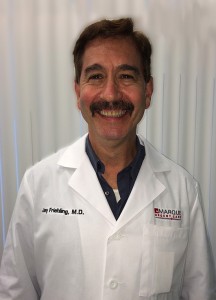Substance Abuse by Jay P. Friehling
Most physicians will encounter patients with substance abuse at some time in their career. Whether it’s a stereotypical middle aged male reeking of alcohol and requesting tranquilizers to calm down, a teenager who smells of marijuana and has bloodshot eyes or a geriatric women who keeps requesting her lost bottle of pain medicines, the face of drug abuse is as varied as there are minutes in the day. Drug and alcohol abuse affects adolescents and the elderly, all races, and all socioeconomic groups. Despite the relatively high prevalence, drug abuse frequently goes undetected. Most often, the abuser has a functional life and only has areas of unmanageability. If left untreated with help, it can lead to more tragic problems. The job of the primary care health provider is to screen patients, make treatment suggestions, encourage avoidance of substances in those abusing, and refer to specialty organizations where appropriate.
Statistics (What’s been going on?)
One study of a nationally representative sample found that eight percent of adults in the U.S. had a substance abuse problem. Another study that conducted urine and blood tests on a sample of patients admitted to the hospital estimated that alcohol or drug use was involved in 14 percent of the medical admissions and 26 percent of the psychiatric admissions. The rate of prescription drug abuse is fast overtaking illegal drug abuse in the United States. According to the National Institute of Drug Abuse (NIDA), 7 million people were taking prescription drugs for nonmedical use in 2010. Among 12th graders, prescription drug misuse is now second only to cannabis. “Nearly 1 in 12 high school seniors reported nonmedical use of Vicodin; 1 in 20 reported abuse of OxyContin. Heroin use, snorting and/or smoking it, has blossomed into epidemic proportions among teens, young and older adults.
Screening (How do I find it?)
The easiest way to find out if someone is abusing substances is to simply ask. Many people will be frankly honest about their use or abuse. As a health care provider, I am in a unique position to help identify patients with problems. But even family members, friends, coworkers or others that interact can inquire. Inquiring about a patient’s drug and alcohol use could save someone months or years of harm. Obviously, many abusers will be dishonest and minimize their involvement with substances. That is to be expected. But, avoiding the subject entirely simply allows the situation to continue- sometimes with a tragic end. In addition, many dependent people will show other signs of problems. These can include isolation, unexplained injuries, erratic behavior, personality changes and changes in job or school performance. The list can go on and on. Sometimes there is also hard evidence. This can be supplies of pills, powders, tobacco or injectable liquids and syringes for which there is no logical justification. Sometimes arrest and/or multiple motor vehicle accidents while driving under the influence occurs. This list can also be extended indefinitely.
Treatment (What can be done?)
The sooner the abuse is identified, the sooner treatment and change can begin. Sometimes simply a discussion or several short discussions can help motivate the abuser to break through the denial. With vigilance and follow up, the problem is resolved. More often, outpatient or inpatient intervention is needed. This sometimes includes a change in locale so that the drug abuser can avoid the tempting influences of his or her current environment and begin to focus on not using/drinking. For the abuser, this can be quite the challenge! Many resources such as therapists, counselors, residential and outpatient programs, 12 step programs, sober living homes and detox and blocker medications are available. Many professionals suggest a multidisciplinary approach that incorporates several of these methods. Some people also end up dealing with legal, financial and other medical problems along with the drug/alcohol issues. But as long as the abuser doesn’t use, many of these other issues can be resolved.
Conclusions (What can we expect?)
The statistics and economic cost of this problem is staggering! In the United States, between the health costs, losses of productivity and societal costs (criminal justice system, etc.), the numbers are in the hundreds of billions of dollars. Health care professionals can deal with this by taking positive actions by Inquiring in the exam room and screening for substance abuse. Ask the extra questions about alcohol and drug use. Refer to other specialized professionals as needed. Educate those patients who might be using or inappropriately taking mind altering prescription medications. Alcohol and drug abuse has been around for many years, and it probably won’t be eradicated in the near future. But when we can identify a problem, we can offer help and encourage people to take positive actions to help themselves and those around them to deal with the realities of life. When the abuser does not resort to the use of substances, society as a whole benefits.
The information provided is for general interest only and should not be misconstrued as a diagnosis, prognosis or treatment recommendation. This information does not in any way constitute the practice of medicine, or any other health care profession. Readers are directed to consult their health care provider regarding their specific health situation. Marque Medical is not liable for any action taken by a reader based upon this information.

